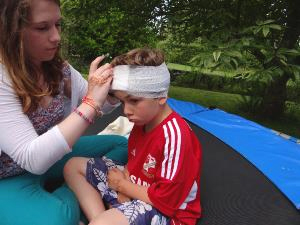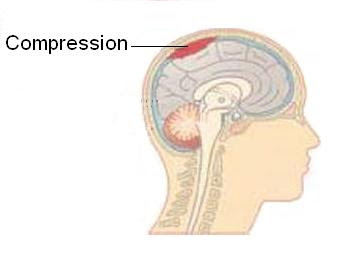3 - 5yrs Clinic
First Aid
Head Injuries - what to do and what to look out for
Fortunately, most falls or blows to the head result in injury to the scalp only, which is usually more frightening than life threatening.
The head and face are very vascular and consequently injuries bleed profusely and can be very scary! An internal head injury may have more serious implications because it could cause damage to the brain.

What to look for and what to do...
Call 999 or 112 if a baby is injured; or if a child has lost consciousness, even momentarily; or if a child of any age has any of these symptoms:
- won’t stop crying
- complains of head and neck pain
- becomes difficult to console
- isn’t walking normally
Compression (Swelling in the brain) can occur immediately or up to 48 hours after the head injury. If the casualty has not lost consciousness, and is alert and behaving normally after the fall or blow:
- Encourage them to stay still while you assess the severity of the injury. A forceful blow to the head can cause spinal injury. If that is the case encourage them to stay still, not to twist and phone an ambulance. It is the twisting movement that can result in spinal cord damage.
- Apply a wrapped ice pack or instant cold pack to the injured area for 10 minutes, to reduce superficial bruising.
- Observe the casualty carefully for the next 48 hours. If you notice any of the signs of brain injury (see below), phone an ambulance immediately.
- If the incident has occurred with a child close to bedtime or naptime and they fall asleep soon afterwards, check in frequently to look for twitching limbs or disturbances in colour or breathing. It is perfectly ok for your child to go to sleep if you are confident there are no unusual signs or behaviour – there is no need to keep someone awake after a head injury.
- If you aren’t comfortable with your child’s appearance (trust your instincts), arouse your child partially by sitting him or her up. Your child should object to this and attempt to resettle. If he or she doesn’t protest, try to wake them fully. If your child can’t be woken, or shows any symptoms of a brain injury (see below) call an ambulance.

Suspected brain injury - Compression
The brain is cushioned by cerebrospinal fluid, but a severe blow to the head may knock the brain into the side of the skull or tear blood vessels. Any internal head injury - fractured skull, torn blood vessels, or damage to the brain itself - can be serious and possibly life threatening. It will result in increasing pressure within the brain which pushes against other parts of the brain and spinal cord. They will need urgent medical attention.
It can be difficult to determine the level of injury, so it’s always wise to discuss a head injury with your doctor. A clear indicator of a more serious injury is when someone loses consciousness, has signs of confusion or any of the symptoms below. These symptoms can come on at any time from immediately after the accident to a couple of days later. It is sensible to have your child sleep in the same room as you for a couple of nights following a head injury.
What to look for and what to do...
Call an ambulance if a casualty shows any of these symptoms:
- losing consciousness
- abnormal breathing
- obvious serious wound or suspected skull fracture
- bleeding or clear fluid from the nose, ear, or mouth
- disturbance of speech or vision
- pupils of unequal size
- weakness or paralysis
- dizziness
- neck pain or stiffness
- fitting
- vomiting more than once - (it is not unusual for children to vomit immediately after an accident as a response to pain, so do not
- panic if your child is sick just once after a head injury - but they should still be checked by a medical professional).
- loss of bladder or bowel control.
If your child is unconscious...
- If they are breathing - roll them into the recovery position (on their side so that their tongue falls forward in their mouth and any vomit can drain away), trying not to twist their neck or spine at all. Any head injury may well have caused spinal damage as the head recoils from the blow.
- If they are not breathing start CPR.
- Call for an ambulance.
If your child is conscious and it is a serious head injury...
- Phone for an ambulance
- Do your best to keep your child calm and still – making sure that they do not twist.
- If there’s bleeding, grab a clean cloth and apply pressure.
- Do not attempt to clean the wound as it could make things worse.
- Do not apply forceful direct pressure to the wound if you suspect the skull is fractured.Do not remove any object that’s stuck in the wound.
 Remember most head injuries do not result in serious damage. Follow the steps above, keep calm and don’t panic.
Remember most head injuries do not result in serious damage. Follow the steps above, keep calm and don’t panic.
First Aid for life provides this information for guidance and it is not in any way a substitute for medical advice. First Aid for Life is not responsible or liable for any diagnosis made, or actions taken based on this information. It is strongly advised that you attend a First Aid course to understand what to do in a medical emergency.
For more information please visit www.firstaidforlife.org.uk

Related Articles
Nurseries: learning through fun
What is the Early Years Foundation Stage?
Koko Kids: a new design boutique
First Aid courses from an award winning London based company
First aid training that could help save a life
Greycoat Lumleys' Emergency nanny lifeline
A bright Montessori future in Brooke Green
Related Products
East Coast, Wooden Combination Highchair
Baroo, cotbed duvet and pillow set
Baby Bjorn, Babysitter Balance
Have Your Say
Be the first person to comment on this article, just post a comment below.






In order to post a comment you need to be a member. Join Now | Sign in